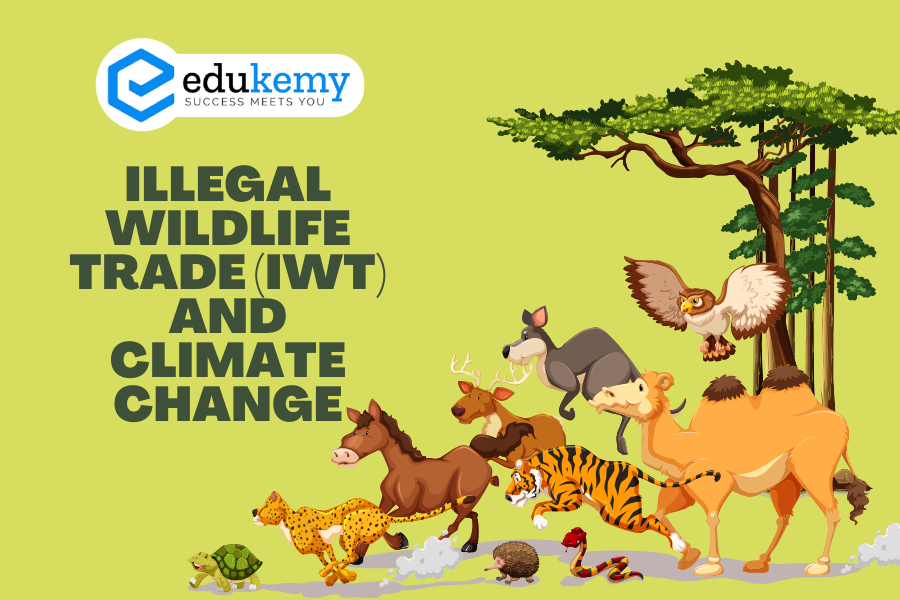Illegal Wildlife Trade (IWT) and Climate Change represent two interconnected global crises, each posing significant threats to biodiversity and the delicate balance of ecosystems worldwide. IWT involves the unlawful exploitation and trafficking of various species, ranging from exotic animals to rare plants, driven primarily by demand for traditional medicine, luxury goods, and exotic pets. On the other hand, Climate Change exacerbates environmental degradation, leading to habitat loss, altered migration patterns, and heightened vulnerability for countless species. These twin challenges not only endanger the survival of diverse flora and fauna but also undermine the ecological services essential for human well-being. As the world grapples with the escalating impacts of both Illegal Wildlife Trade and Climate Change, urgent action and international cooperation are imperative to safeguard the planet’s rich biological heritage and secure a sustainable future for generations to come.
The United Nations Office on Drugs and Crime (UNODC) has recently published a document titled “Connecting the Dots: Illegal Wildlife Trade and Climate Change.” This release took place as part of a side event held during COP27 in Sharm El-Sheikh, Egypt.
Contents
- 1 KEY HIGHLIGHTS OF THE PAPER
- 2 FAQs: ILLEGAL WILDLIFE TRADE AND CLIMATE CHANGE
- 2.1 Q1: What is the significance of the document “Connecting the Dots: Illegal Wildlife Trade and Climate Change”?
- 2.2 Q2: Where was the document released, and during which event?
- 2.3 Q3: What key aspect does the paper highlight regarding the approach to addressing IWT?
- 2.4 Q4: How does the paper urge policymakers to view IWT in relation to climate change?
- 2.5 Q5: What are the five types of relationships delineated in the document?
- 2.6 Q6: What is the highlighted role of Dalbergia trees in the paper?
- 2.7 Q7: Why are elephants, white rhinos, and pangolins referred to as “Ecosystem Engineers”?
- 3 In case you still have your doubts, contact us on 9811333901.
KEY HIGHLIGHTS OF THE PAPER
- Broadening Perspective on Illegal Wildlife Trade (IWT):
- The paper emphasizes the need to go beyond the conservation standpoint when addressing illegal wildlife trade (IWT). It underscores the cascading impact of IWT on ecosystem functionality and processes influencing climate.
- Ecosystem Services and Climate Change:
- Policymakers are urged to recognize IWT not just as a threat to species survival but as having significant implications for ecosystem services related to climate change.
- Five Types of Relationships:
- The paper delineates five types of relationships between IWT and climate change, elucidating the multifaceted impact of IWT on ecosystem functioning and resilience, including effects on carbon stocks.
- Role of Dalbergia Trees:
- Highlighting the role of Dalbergia trees, the paper underscores their commercial importance for high wood density. Simultaneously, it emphasizes their critical role in long-term carbon sequestration and storage.
- Ecosystem Engineers – Elephants, White Rhinos, and Pangolins:
- The report identifies elephants, white rhinos, and pangolins as “Ecosystem Engineers” due to their contribution to shaping fundamental abiotic processes in their respective habitats.
- African Forest Elephant Impact:
- The African Forest Elephant’s population decline by 86% in the last three decades is linked to habitat loss and illegal poaching for ivory. The species influences nutrient transport, plant communities, and carbon stocks, with potential repercussions for Central African rainforests.
- Rhinos and Carbon Cycle:
- Rhinos, listed as near threatened, impact the carbon cycle through soil compaction and disturbance, crucial factors in controlling wildfires—a significant source of carbon emissions.
- Pangolins’ Role in Regulation:
- Pangolins, highly trafficked animals, play a unique role in regulating ant and termite populations. Termites, while contributing to the decomposition process, account for 1 to 3% of natural global annual emissions.
The paper highlights these aspects to underscore the intricate connections between IWT, biodiversity, and climate change, urging comprehensive approaches to conservation and sustainable ecosystem management.
FAQs: ILLEGAL WILDLIFE TRADE AND CLIMATE CHANGE
Q1: What is the significance of the document “Connecting the Dots: Illegal Wildlife Trade and Climate Change”?
A: The document sheds light on the intricate connections between Illegal Wildlife Trade (IWT) and climate change, urging a broader perspective beyond species conservation.
Q2: Where was the document released, and during which event?
A: The document was released by the United Nations Office on Drugs and Crime (UNODC) during a side event at COP27 in Sharm El-Sheikh, Egypt.
Q3: What key aspect does the paper highlight regarding the approach to addressing IWT?
A: The paper emphasizes the need to move beyond a conservation standpoint, recognizing the cascading impact of IWT on ecosystem functionality and its influence on climate processes.
Q4: How does the paper urge policymakers to view IWT in relation to climate change?
A: Policymakers are urged to recognize IWT not only as a threat to species survival but as having substantial implications for ecosystem services linked to climate change.
Q5: What are the five types of relationships delineated in the document?
A: The paper elucidates five types of relationships between IWT and climate change, providing insights into the multifaceted impact of IWT on ecosystem functioning, resilience, and carbon stocks.
Q6: What is the highlighted role of Dalbergia trees in the paper?
A: Dalbergia trees are underscored for their commercial importance in terms of high wood density and their critical role in long-term carbon sequestration and storage.
Q7: Why are elephants, white rhinos, and pangolins referred to as “Ecosystem Engineers”?
A: These animals are termed “Ecosystem Engineers” due to their significant contributions to shaping fundamental abiotic processes in their respective habitats.
In case you still have your doubts, contact us on 9811333901.
For UPSC Prelims Resources, Click here
For Daily Updates and Study Material:
Join our Telegram Channel – Edukemy for IAS
- 1. Learn through Videos – here
- 2. Be Exam Ready by Practicing Daily MCQs – here
- 3. Daily Newsletter – Get all your Current Affairs Covered – here
- 4. Mains Answer Writing Practice – here

